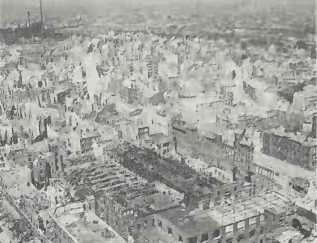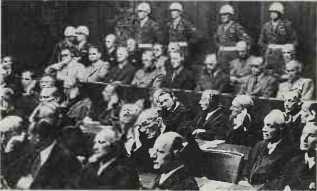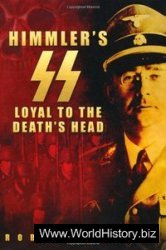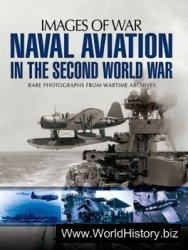Then Narvik had lost operational priority.
Appeals from the Norwegian government to help re-take Trondheim and to check the German advance north from Oslo, led to an Allied decision to intervene in Central Norway. A direct attack on the city was rejected as too hazardous. Instead, an envelopment was attempted with the landings of British and French troops at Namsos to the north on April 16, and of British troops only at Andalsnes to the south two days later. Allied operations were under the command of Lt Gen Massy.
Luftwaffe bombing soon made it impossible to unload ships in daylight at either port. With barely four hours of darkness at that latitude, and with only the most primitive port facilities, logistic support of both forces became impracticable. A squadron of raf Gladiator fighters was landed on a frozen lake near Andalsnes, but only operated for a day before the ice was broken up by German bombing. Fighter cover from carriers and long-range raf attacks proved ineffective. A decision to abandon central Norway and to concentrate once more on securing Narvik was taken on April 27. The hazardous evacuations of Andalsnes and Namsos were completed by May 3.
The collapse of British efforts to re-take Trondheim led to Chamberlain’s replacement by Churchill as British Prime Minister. Lt Gen Auchinleck was sent to take command of the British, French, Polish and Norwegian land forces by then besieging Narvik. He arrived on May 11, but again operations at Narvik lost importance because the German invasion of France had started on May 10. Although Narvik fell on May 28, a decision to abandon northern Norway had been made in London on May 24.
The evacuation of Narvik on June 8 was marred by the loss of the carrier Furious in a chance encounter with Gneisenau and Scharnhorst, both of which suffered serious damage, leaving the German fleet without a major unit fit for sea by the end of the campaign. The German occupation of Norway was completed when Gen Ruge, the Norwegian c-in-c, accepted armistice terms on June 9
1940. WGFJ.
Notre Dame de Lorette. Commanding spur, northwest of Vimy Ridge, captured by the French Tenth Army, after heavy fighting, in May 1915.
Nowotny, Maj Walter (1920-1944). Austrian. Highest-scoring Austrian (and fifth-highest-scoring Luftwaffe) fighter pilot of World War II. With 255 “kills” over Russia, Nowotny returned to Germany to command Erprobungs Kom-mando Nowotny, first Messers-chmitt Me 262 fighter unit, operational October 1944. After scoring three victories, he was killed on November 8 1944.
Noyon-Montdidier, Battle of see
MARCH OFFENSIVE, GERMAN (lOJS).
Nuclear weapon. The proper name for weapons that use the energy locked up in the nucleus of the atom, where the strong nuclear force binds together electrostatically repellent protons and neutral neutrons. Certain “fissile” materials, notably uranium-235 and plutonium-239, can be induced to produce explosive nuclear chain reactions in the right or critical mas-ses/densities. A neutron source causes one nucleus to fission, which produces neutrons, which produce more fissions, etc. A robust old form of nuclear weapon was the “gun” type, in which a small piece of uranium-235 was shot into a larger piece, producing criticality. A more efficient form is to implode a sub-critical sphere of fissile material to critical density. Fission nuclear weapons have yields in the kiloton range which can be boosted using thermonuclear material and form the “primaries” of thermonuclear weapons proper. EJG.
Nungesser, Capt Charles Eugene Jules Marie (1892-1927). Fr. Third highest-scoring French fighter pilot of World War I, with 45 “kills”. Flamboyant and aggressive, Nungesser was seriously injured, in combat or accidents, more than 12 times. He disappeared while attempting a solo east-to-west crossing of the Atlantic.
Nuremberg, bombing of, (March 30-31 1944). RAF Bomber Command’s most disastrous major attack: of 795 aircraft dispatched,

Nuremberg after raf raid, 1944
94 failed to return and 74 were damaged, (12 beyond repair). The German night-fighter force inflicted most casualties. An undeviating route from Charleroi eastward for nearly 250 miles (400km) to near Fulda took the bombers past the known positions of two night-fighter beacons, giving the fighters exceptional opportunities for interception (more than 40 combats on the long leg), and making the eventual target obvious. No diversionary operations were mounted. In the target area, where visibility was unexpectedly good, there were 23 combats. ANF.
Nuremberg Rallies. Spectacular Nazi Party celebrations first held in 1923 and increasing in size throughout the 1930s.

Nuremberg; Nazis in the dock
Nuremberg Trials. Military Tribunal convened by Britain, USA, France and Soviet Union following victory in Europe, 1945. In the principal trial, November 20
1945-September 30 1946, 21 surviving Nazi leaders were charged with various “war crimes”: 11 were condemned to death, 7 to long imprisonment and 3 acquitted. Although the charges were based on internationally accepted laws and conventions, doubts have been expressed concerning the ethics of the victors judging the vanquished. MS.




 World History
World History









